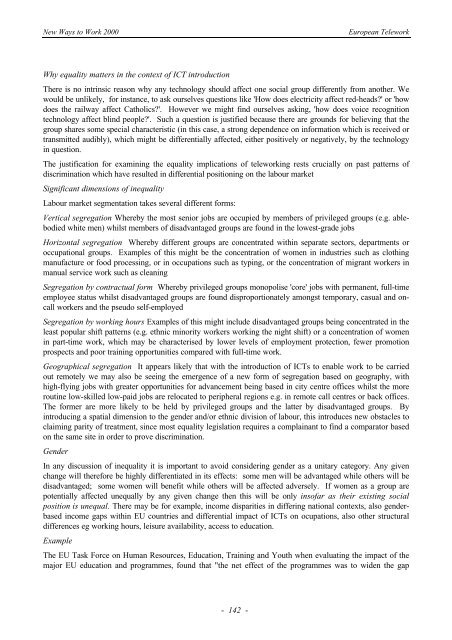eWORK 2000 - European Telework Week
eWORK 2000 - European Telework Week
eWORK 2000 - European Telework Week
- No tags were found...
You also want an ePaper? Increase the reach of your titles
YUMPU automatically turns print PDFs into web optimized ePapers that Google loves.
New Ways to Work <strong>2000</strong><strong>European</strong> <strong>Telework</strong>Why equality matters in the context of ICT introductionThere is no intrinsic reason why any technology should affect one social group differently from another. Wewould be unlikely, for instance, to ask ourselves questions like 'How does electricity affect red-heads?' or 'howdoes the railway affect Catholics?'. However we might find ourselves asking, 'how does voice recognitiontechnology affect blind people?'. Such a question is justified because there are grounds for believing that thegroup shares some special characteristic (in this case, a strong dependence on information which is received ortransmitted audibly), which might be differentially affected, either positively or negatively, by the technologyin question.The justification for examining the equality implications of teleworking rests crucially on past patterns ofdiscrimination which have resulted in differential positioning on the labour marketSignificant dimensions of inequalityLabour market segmentation takes several different forms:Vertical segregation Whereby the most senior jobs are occupied by members of privileged groups (e.g. ablebodiedwhite men) whilst members of disadvantaged groups are found in the lowest-grade jobsHorizontal segregation Whereby different groups are concentrated within separate sectors, departments oroccupational groups. Examples of this might be the concentration of women in industries such as clothingmanufacture or food processing, or in occupations such as typing, or the concentration of migrant workers inmanual service work such as cleaningSegregation by contractual form Whereby privileged groups monopolise 'core' jobs with permanent, full-timeemployee status whilst disadvantaged groups are found disproportionately amongst temporary, casual and oncallworkers and the pseudo self-employedSegregation by working hours Examples of this might include disadvantaged groups being concentrated in theleast popular shift patterns (e.g. ethnic minority workers working the night shift) or a concentration of womenin part-time work, which may be characterised by lower levels of employment protection, fewer promotionprospects and poor training opportunities compared with full-time work.Geographical segregation It appears likely that with the introduction of ICTs to enable work to be carriedout remotely we may also be seeing the emergence of a new form of segregation based on geography, withhigh-flying jobs with greater opportunities for advancement being based in city centre offices whilst the moreroutine low-skilled low-paid jobs are relocated to peripheral regions e.g. in remote call centres or back offices.The former are more likely to be held by privileged groups and the latter by disadvantaged groups. Byintroducing a spatial dimension to the gender and/or ethnic division of labour, this introduces new obstacles toclaiming parity of treatment, since most equality legislation requires a complainant to find a comparator basedon the same site in order to prove discrimination.GenderIn any discussion of inequality it is important to avoid considering gender as a unitary category. Any givenchange will therefore be highly differentiated in its effects: some men will be advantaged while others will bedisadvantaged; some women will benefit while others will be affected adversely. If women as a group arepotentially affected unequally by any given change then this will be only insofar as their existing socialposition is unequal. There may be for example, income disparities in differing national contexts, also genderbasedincome gaps within EU countries and differential impact of ICTs on ocupations, also other structuraldifferences eg working hours, leisure availability, access to education.ExampleThe EU Task Force on Human Resources, Education, Training and Youth when evaluating the impact of themajor EU education and programmes, found that "the net effect of the programmes was to widen the gap- 142 -








